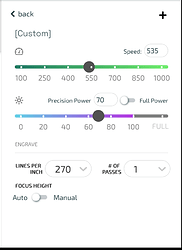Yes, the slower the speed, the longer the laser beam will be hitting the material, but that’s offset by a rather low power which will burn away less material. (Also notice I used a bit higher lines per inch, which will also make an engraving a bit deeper.) But that doesn’t mean other settings might not work too and that’s why it’s always good to test each material to figure out which one give you the best results; sometimes slow and low looks a lot better than fast and hot, and it really just depends on the material and artwork. (But I know you can’t test on your box , and I’m just talking in general. ![]() )
)
Here’s another discussion about cedar where you’ll see that @ovm.steve also used a bit lower speed and power, but his LPI was lower than mine.
And I looked up the janka scale for basswood and it’s just little harder than paulownia, so lowering the power on the proofgrade basswood hardwood setting just a bit might also be a good starting point for you. (Here’s the proofgrade setting and you can see it’s more speed and power than mine, but that’s offset by a lower LPI, and I think it would give you similar results.)

